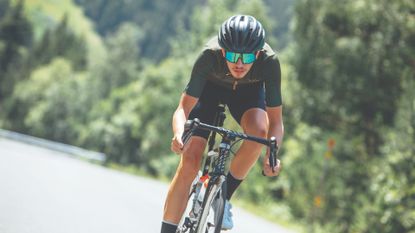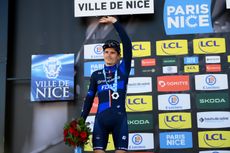Power vs aerodynamics: what is the best balance and how can I achieve it?
Watts and aerodynamics are two cornerstones of our cycling performance - but favoring only one will see you going slower than a more balanced approach. Here’s our guide to better optimising your speed
- (opens in new tab)
- (opens in new tab)
- (opens in new tab)
- Sign up to our newsletter Newsletter


We all know that power output is significant when it comes to performance: if all else is held equal, then putting out more power will see you going faster. The amount of power that can be sustained for any given duration is one of the starkest differences between professional cyclists and keen amateur riders - and it’s something we have even more exposure to today thanks to live power data feeds during races.
Over the past two decades, we’re also become a lot more exposed to the importance of aerodynamics within cycling. This learning continues as bike brands compete to produce ever more aerodynamic designs and as the pros contort themselves to adopt the most aerodynamically optimised positions - which the UCI will occasionally promptly ban.
The focus on aerodynamics does make sense - when we ride on the flats, as much as 80-90 per cent of the forces we are having to overcome can be air resistance. But is there a turning point where the hunt for aero gains can compromise performance, due to a reduced ability to put out the power?
Consider Chris Froome’s daring top tube descending attack: his power output was heavily reduced but - in that scenario - it was aerodynamics that was king and the balance was tipped heavily against raw power.
But that’s not necessarily always the case. At its most simple, you don’t see anyone emulating Chris Froome’s position when riding on the flat - there, although aerodynamics is still hugely important, the balance is still that much more in favour of physiological power. But where, exactly, does the balance lie?
How many watts can you save through aerodynamics?

This is a question where the answer ultimately is: ‘it depends’.
As we increase our velocity, the air resistance we encounter increases at a greater rate. An easy to understand - but not fully accurate - rule of thumb is: at 10kph we experience two units of drag, at 20kph it is four, and at 30kph it is 16. So, for Filippo Ganna at his hour record pace, the air resistance he had to overcome would have been substantially higher!
We can reduce the effect of air resistance on us by reducing our coefficient of aerodynamic drag (CdA). CdA is determined by the size, shape and surface texture of the moving object. Examining Ganna, we see that his bike had narrow tubing, extending backwards to create a more aerodynamic shape.
We can also see, under his skinsuit, a base layer designed to affect the texture of his shape. This design was also employed on the seat tube and downtube where, thanks to 3D printing, the frame could be made into shapes not previously possible. So, although Ganna has astronomical power output, without getting his CdA as low as possible he would not have set a time anywhere near as fast as he did.
However, we can’t all cruise around at 56.7kph, so how does aerodynamics affect us mortals? Let’s take a 40kph time trial: if you have a CdA of 0.25, you will need maybe around ~250 watts to do that speed. With a CdA of 0.22, you will need ~220 watts. However, increasing that to 50kph and 0.25 will require more like ~400 watts and 0.22 around ~350 watts.
We can see here that the reduction in CdA saves more watts at a higher speed but, at lower speeds, the CdA reduction results in a greater speed increase for the same power. So, although you save more watts at higher speeds, those of us riding at 30kph can also increase their speed more with the same reductions in CdA. Essentially, aero matters to all of us if we want to get faster.
This can be achieved by splashing out on fancy aero bikes, deep section wheels and tech-heavy skinsuits. But there are also many ways of boosting your aerodynamics for free - and with rider position being such a large factor in aerodynamics, some of the biggest gains can actually be made without any expense.
What happens if aerodynamics are prioritised over watts?
The problem with the relentless pursuit of aerodynamics is that it can affect power output if done incorrectly. For example, the quickest ‘aero’ position could be to reduce your saddle height, move the saddle back, drop the front end, and bring your arms close together. However, an extreme change of position like this will impact negatively on power output, both in the short term and the long term.
In this (extreme) scenario, hip angle is reduced, knee angle is reduced, shoulders are stretched out, and breathing possibly restricted. All of this is likely to impact power output severely, so the overall Watts/CdA equation doesn’t get better. In the same way, getting too lean/lightweight may not improve climbing performance as Watts/Kilo either remains static or decreases. Again, it’s all about balance.
How can we ensure that power output isn’t compromised in the pursuit of aerodynamics?

As is the case with most aspects of training, it requires time, commitment, and adaptations. Of course, when it comes to changing position in the hunt of aerodynamic gains, there are biomechanical constraints to consider. However, many of the potential issues of pursuing an aero position (and the associated power loss) can be alleviated by implementing certain strategies.
Firstly, training time. It’s no secret that the best time triallists and aero extraordinaires spend a lot of time training in the TT position. The TT bike isn’t something they bring out in the summer, just for the race season. No, over winter they spend hours on the turbo in an aero tuck or brave the elements for longer outdoor rides. Spending long hours training in the aero tuck helps them adapt to the position and improves their capacity to produce power, even if the aero position initially compromises it slightly.
Next up, we have off-bike adaptations. Using good strength and conditioning, we can drastically improve our capacity to produce power on the bike, even under more extreme aero positions. We can reduce the saddle height if we increase our capacity for dorsiflexion (heel dropping).
We can also lower the front end more if we increase our power production at smaller hip angles by doing exercises such as deep squats in the gym. Ensuring you keep your neck, shoulders, back and posterior chain muscles strong and flexible can also help you maintain power when in a more stretched out position on the bike, without experiencing referred tightness in the glutes or hamstrings.
So, in all, although there is always a limit as to how extreme a position you can achieve before you compromise power, there are several strategies that can help to alleviate these issues and ensure that your Watts/CdA is optimised.
THE PHYSIOLOGIST’S VIEW
“Producing optimal power at the pedals is inextricably linked to riding position,” says Dr Simon Marwood, senior lecturer in physiology at Liverpool Hope University.
"Functional Threshold Power [FTP] is a close approximation of the upper limit of the physiological steady state. At this threshold, a steady state is achieved for oxygen uptake, blood lactate and energy provision.
"Above the lactate threshold, there is reliance on anaerobic metabolism to meet the energy demands of exercise.”
A hunched-over position can affect this by closing your chest, squeezing your shoulders together and tucking your chin, reducing your ability to uptake oxygen, thus lowering your threshold.
"Above FTP, a physiological steady state is unattainable; blood lactate and oxygen uptake rise inexorably until maximal oxygen uptake [VO2 max] is achieved.
"Shortly, fatigue ensues and it is necessary to drop below FTP in order for exercise to continue."
Keeping your FTP as high as possible therefore delays the excruciating demise of your legs. Set too extreme a position and you will drift into ‘the red’ — the anaerobic state — sooner than you need to.
The bottom line is, small aerodynamic gains are worthless if they result in a significant drop in FTP.
THE BIKE-FITTER’S VIEW

Tweaking your riding position unsupervised is a risky business. Here, Retul master Garth Kruger of Vankru Cycles sets out the priorities:
“85 per cent of people who visit us for a bike-fit are triggered to do so by an injury. So, injury prevention and comfort are higher priorities than aerodynamics for us.
“The challenge for a bike-fitter is that what’s aero for one person isn’t necessarily as aero for another, but there are general principles to follow. Educated guesses can be made, but without the appropriate equipment, it will always be a guess.
“The biggest limiting factor in how aggressive a position a rider can hold is their flexibility and core strength. Improving shoulder, hip flexor and hamstring flexibility will also get you closer to your dream position.”
Is your riding position too extreme? Here are Garth's top warning signs and advice.
Heads up
“You should be able to hold your head up comfortably for the duration of your event without pain.”
Back pain
“If you're getting lower back pain after an hour, something needs to change. Take a look at the range of motion in your hamstrings and hip flexors, as these areas are often the cause of the problem.”
Shoulders
“In a poorly-fit position you may experience pain if your shoulders are supporting your weight. Often we see people who can’t ride in their aerobars for more than five minutes without shoulder pain.”
The cost of pain
“If you sit up to alleviate the pain, then the time lost from riding in an upright position with poor aerodynamics will far outweigh any gains you could have made from your extreme position.”
Preliminary self-testing
“Before focusing on aerodynamics, try to ensure that you are ‘functionally adequate’. This means you can perform a deep single-leg squat, hold a plank for at least one minute and touch your toes while keeping a flat back.
"Only then are you likely to be able to tolerate an aggressive riding position. If you can’t complete these exercises satisfactorily, you should start with comfort as your primary goal and aero in second place.”
THE CYCLING COACH’S VIEW

“Think of your goals when you consider bringing aerodynamics into the equation,” says Ken Buckley, head coach at Buckley Performance Coaching. “Start with the easy improvements: tight-fitting clothing, reducing your frontal area, using deeper-section wheels and helmets designed to be aerodynamic.
“Aero trumps weight in all but the most severe parcours.
“So spend less time being a weight weenie and eating salads and more time working on being able to hold an aerodynamic tuck and fuelling your training correctly in order to increase power output.
“There will be a point where you push your riding position too far. The only way to discover this is through fitness testing.
“Use a power meter to test your FTP in a comfortable upright position where you can breathe deeply and move freely; this serves as a benchmark for your current physiological maximum.
“If the results of the test say that your FTP is 250 watts but you can only hold this power output for five minutes when riding on the drops or the aerobars, you immediately know your power has been compromised.
“Your FTP should be sustainable for between 45 and 60 minutes.
“If you don’t fancy continual FTP fitness tests, use interval sessions to judge how difficult it feels. Feel is very important, but use all data at your disposal: power, heart rate and perceived exertion.
“My top tip for adapting to an extreme position is to build things up slowly. Start by riding in a comfortable position during your warm-ups and only using your aero tuck while completing your hard efforts or intervals.
“This will help you to hold your position and stay focused on not letting it slip.
“Remember, riding at 10mph or slower, aerodynamics is not so important, whereas if you find yourself riding at speed into the wind, it’s time to drop some aero bombs.
“Try to ensure your FTP does not slip more than 10 per cent through a change in riding position; from there, aim to adapt and eventually close that gap.”
The verdict
Ask yourself: does my aero-power balance need attention? Like many key questions in cycling, there is no straightforward answer.
To determine if you have found the right balance between power and aerodynamics, you need to address your cycling goals. If you are riding purely for the enjoyment of the sport, then putting yourself through the arduous task of examining your aerodynamics will not fill you with the joys of spring.
However, if you have even the slightest concern for speed, performance or completing a tough personal challenge, aerodynamics should be near the top of your list.
Developing power in an aero tuck and dedicating hours of your life deliberating over equipment selection is less fun than just riding your bike.
But if your goals are to ride faster, then the value of achieving a super-slippery aero position is unquestionable.

Thank you for reading 10 articles this month* Join now for unlimited access
Enjoy your first month for just £1 / $1 / €1
*Read 5 free articles per month without a subscription

Join now for unlimited access
Try first month for just £1 / $1 / €1
Andy is a Sport & Exercise Scientist, fully qualified and experienced cycling coach, personal trainer and gym instructor. He spent 3 years on the road riding for a UCI cycling team and 7 years as a BC Elite rider.
After graduating in 2020 with first-class honours in his Sport & Exercise Sciences BSc, he continued to pursue his interest in research in the field of sport science alongside setting up his coaching business, ATP Performance, and working for USA-based firm, Wahoo Sports Science. He balanced this with racing at international level, competing in prestigious events such as the Tour of Britain and the Volta a Portugal.
-
-
 Summit finish and final day time-trial for 2024 Tour de France finale in Nice
Summit finish and final day time-trial for 2024 Tour de France finale in NiceStage 20 will finish atop the Col de la Couillole before final day race against the clock in Nice
By Tom Thewlis • Published
-
 Closing the gap: David Gaudu emerges from Paris-Nice more confident than ever before
Closing the gap: David Gaudu emerges from Paris-Nice more confident than ever beforeThe Groupama-FDJ rider finished second overall at the Race to the Sun, but gained more than just the result
By Adam Becket • Published

